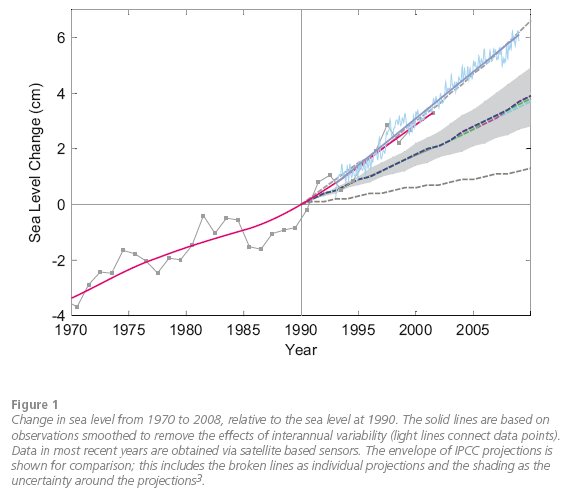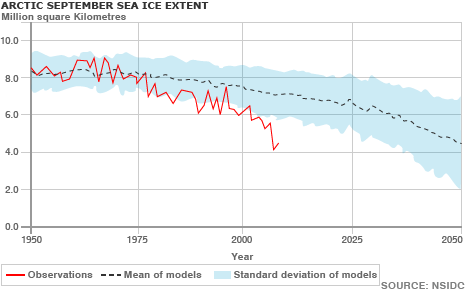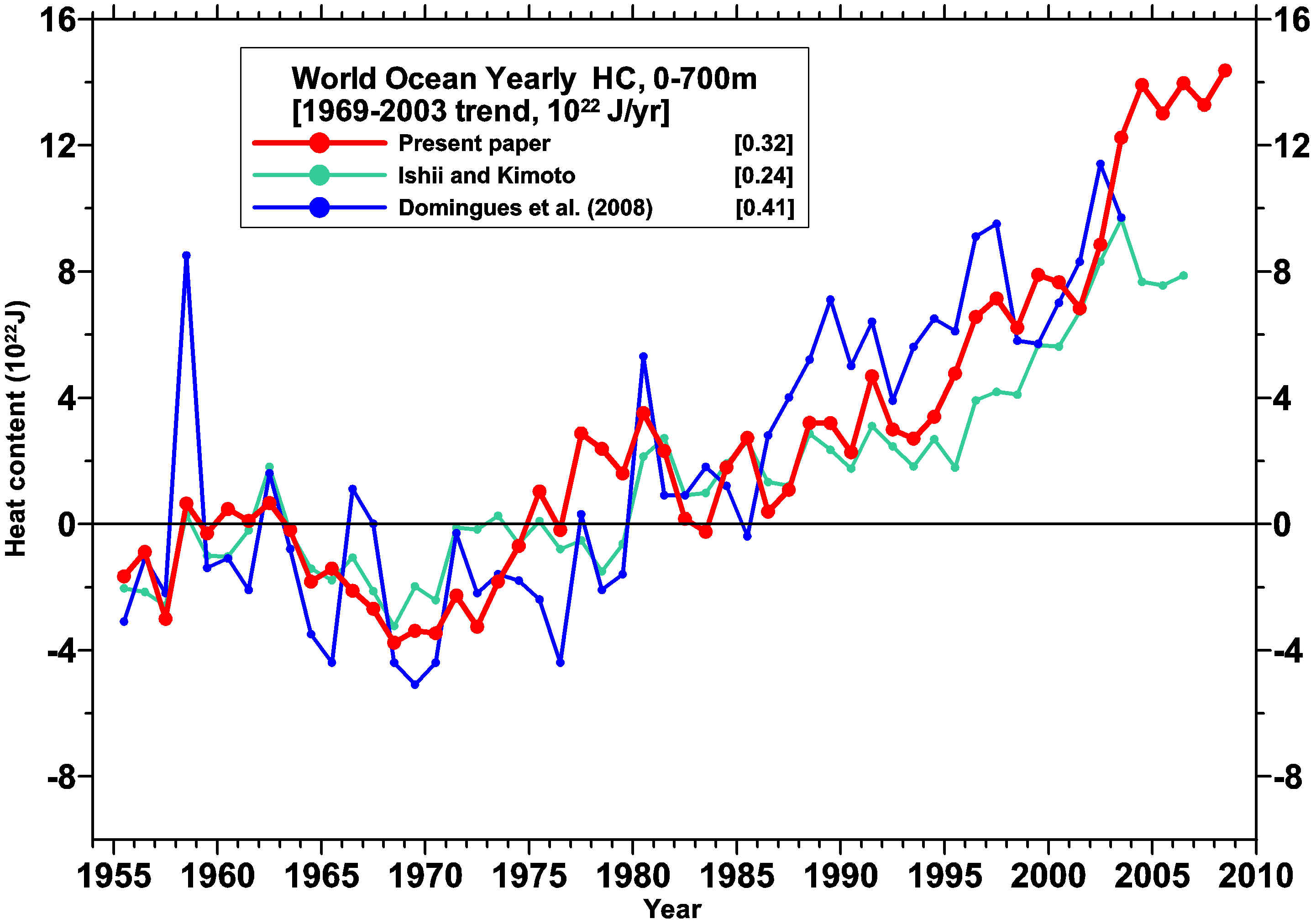RealClimate has just eviscerated Roger Pielke, Sr. in an important post, “More bubkes.” I am going to excerpt it at length because:
- It thoroughly debunks some now-standard denier talking points on sea level rise, ocean heat content, and Arctic sea ice that the Pielkes, WattsUpWithThat, Inhofe, George Will and others have been pushing.
- It has some excellent figures, including ones from the recent major peer-reviewed synthesis report of climate science since the 2007 IPCC report (which I wrote about here).
- Pielke Sr. accused me of “a failure to understand the physics of global warming and cooling” in a post (here) about ocean heat content (which was gleefully reprinted by the anti-scientific website WattsUpWithThat), even though, as RealClimate definitively shows, it is Pielke who either fails to understand the science or chooses to willfully misrepresent it.
In my post “Breaking: NOAA puts out ‘El Niño Watch,’ so record temperatures are coming and this will be the hottest decade on record,” I had noted that Pielke Sr. loves to cherry-pick climate data over short time spans to make misleading scientific claims about climate. Climate, of course, is about long-term trends.
The basis for Pielke’s claim I don’t understand the science of climate: “There are peer reviewed analyses that document that upper ocean warming has halted since 2003…. Even the last few years of the Levitus et al 2009 paper shows this lack of warming (see).” And then he links to his discussion of that paper and puts up this figure:
What serious climate scientist would look at that data and have the nerve to tell the public it documents that upper ocean warming has halted since 2003. If you wanted to play this game – and game is a kind word for this willful attempt to mislead the public – you could much more truthfully say “upper ocean warming has soared since 2002.” But both statements are beside the point.
How could any serious climate scientist possibly look at such noisy data, which is full of short-term gyrations and brief, multi-year periods of little obvious warming – but an unmistakable upward trend for decades – and have the audacity to pick the year right after a staggeringly rapid increase in upper ocean warming as the basis of his public pronouncements on this issue? And Pielke Sr. has the chutzpah to say my writing exhibits “a failure to understand the physics of global warming and cooling.” Doctor – heal thyself. It’s sad, really, since, unlike his son, he is actually a “climatologist.”
Pielke Sr. tries the same crap on the climate scientists of RealClimate – and their devastating must-read response should end forever any notion that Roger Pielke, Sr. is a credible source on climate science:
Roger Pielke Sr. has raised very strong allegations against RealClimate in a recent blog post. Since they come from a scientific colleague, we consider it worthwhile responding directly.
The statement Pielke considers “misinformation” is a single sentence from a recent posting:
Some aspects of climate change are progressing faster than was expected a few years ago – such as rising sea levels, the increase of heat stored in the ocean and the shrinking Arctic sea ice.
First of all, we are surprised that Pielke levelled such strong allegations against RealClimate, since the statement above merely summarises some key findings of the Synthesis Report of the Copenhagen Climate Congress, which we discussed last month. This is a peer-reviewed document authored by 12 leading scientists and “based on the 16 plenary talks given at the Congress as well as input of over 80 chairs and co-chairs of the 58 parallel sessions held at the Congress.” If Pielke disagrees with the findings of these scientists, you’d have thought he’d take it up with them rather than aiming shrill accusations at us. But in any case let us look at the three items of alleged misinformation:
1. Sea level. The Synthesis Report shows the graph below and concludes:
Since 2007, reports comparing the IPCC projections of 1990 with observations show that some climate indicators are changing near the upper end of the range indicated by the projections or, as in the case of sea level rise (Figure 1), at even greater rates than indicated by IPCC projections.

This graph is an update of Rahmstorf et al., Science 2007, with data through to the end of 2008. (Note the comparison is with IPCC TAR projections, but since AR4 projections are within 10% of the TAR models this makes little difference.)
Pielke claims this is “NOT TRUE” (capitals and bold font are his), stating “sea level has actually flattened since 2006” and pointing to this graph. This graph shows a sea level trend over the full satellite period (starting 1993) of 3.2 +/- 0.4 mm/year and is very similar to an independent French analysis of those very same satellite data shown in the Synthesis Report (blue lines above). The best estimate of the IPCC models for the same time period is 1.9 mm/year (coloured dashed lines in the middle of the grey uncertainty range). Hence the conclusion of the Synthesis Report is entirely correct.
The “flattening of sea level since 2006” that Pielke refers to is beside the point and deceptive for several reasons (note too that Anthony Watts has extended this even further to declare that sea level from 2006 to present is actually “flat”!). First of all, trends over such a short sub-interval of a few years vary greatly due to short-term natural variations, and one could get any result one likes by cherry-picking a suitable interval (as Pielke and Lomborg both have). The absurdity of this approach is seen by picking an even more recent trend, say starting in June 2007, which gives 5.3+/-2.2 mm/yr! Secondly, this short-term trend (1.6 +/- 0.9 mm/yr) is not even robust across data sets — the French analysis shown above has a trend since the beginning of 2006 of 2.9 mm/year, very similar to the long-term trend. Third, the image Pielke links to shows the data without the inverted barometer correction — the brief marked peak in late 2005, which makes the visual trend (always a poor choice of statistical methodology) almost flat since then, disappears when this effect is accounted for. This means the 2005 peak was simply due to air pressure fluctuations and has nothing to do with climatic ocean volume changes. The trend from 2006 in the data with the inverse barometer adjustment is 2.1 +/- 0.8 mm/yr.
2. Ocean heat content. The Synthesis Report states:
Current estimates indicate that ocean warming is about 50% greater than had been previously reported by the IPCC.
This is a conclusion of a revised analysis of ocean heat content data by Domingues et al., Nature 2008, and it applies to the period 1961-2003 also analysed in the IPCC report. Pielke claims this is “NOT TRUE” and counters with the claim: “There has been no statistically significant warming of the upper ocean since 2003.” But again this is not relevant to the point the Synthesis Report actually makes and again, Pielke is referring to a 5-year period which is too short to obtain statistically robust trends in the presence of short-term variability and data accuracy problems (the interannual variability for instance differs greatly between different ocean heat content data sets):
For good reasons, the Synthesis Report discusses a time span that is sufficiently long to allow meaningful comparisons. But in any case, the trend in from 2003 to 2008 in the Levitus data (the Domingues et al data does not extend past 2003), is still positive but with an uncertainty (both in the trend calculation and systematically) that makes it impossible to state whether there has been a significant change.
3. Arctic Sea Ice. The Synthesis Report states:
One of the most dramatic developments since the last IPCC Report is the rapid reduction in the area of Arctic sea ice in summer. In 2007, the minimum area covered decreased by about 2 million square kilometres as compared to previous years. In 2008, the decrease was almost as dramatic.
This decline is clearly faster than expected by models, as the following graph indicates.

Pielke’s claim that this is “NOT TRUE” is merely based on the statement that “since 2008, the anomalies have actually decreased.”
Yes, same thing again: Pielke’s argument is beside the point, since the Synthesis Report is explicitly talking about the summer sea ice minimum reached each September in the Arctic, and we don’t even know yet what its value will be for 2009. And Pielke is again referring to a time span (“since 2008“!) that is far too short to have much to do with climatic trends.
We thus have to conclude that there are no grounds whatsoever for Pielke’s wild allegations against us and implicitly the Synthesis Report authors. The final sentence of his post ironically speaks for itself:
Media and policymakers who blindly accept these claims are either naive or are deliberately slanting the science to promote their particular advocacy position.
Indeed.
Yes, Pielke actually wrote that the scientific observation that Arctic sea that is “progressing faster than was expected a few years ago” is NOT TRUE because of data “since 2008.” What’s next, Dr. Pielke, we are going to to tell the public that the climate didn’t change since a week ago?
If a graduate student had tried this crap during a thesis defense, he would be denied his degree and thrown out of the Ph.D. program.
It simply boggles the mind to see someone who was once considered a serious climate scientist descend into this kind of desperate misinformation – which is all the sadder for him because it is here permanently in the blogosphere for everyone to seek, including, one hopes, the media.
If you didn’t know beforehand that this guy was Roger Pielke, Jr.’s father, it certainly wouldn’t come as a big surprise:
- Why do deniers like Pielke shout down any talk of a link between climate change and extreme weather?
- Roger Pielke, Jr. baselessly smears the good name of hundreds of top U.S. scientists
- Pielke in Nature: “Clearly, since 1970 climate change … has shaped the disaster loss record.”
- Uber-denier Inhofe misquotes Hadley, gives big wet Valentine’s kiss to Pielke – go figure!
- Finally, Roger Pielke admits he supports policies that will take us to 5-7°C warming or more
And again, let me end with the warning sign that should flash in every journalist’s mind when they read or hear a statement by anyone named “Roger Pielke”:




